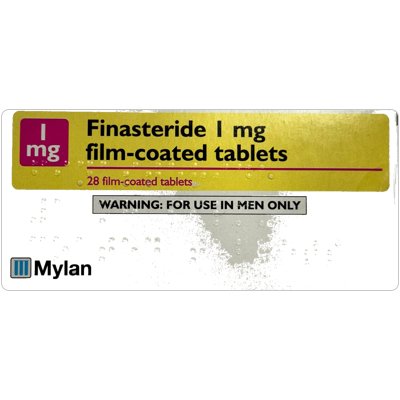Finasteride
Finasteride is a medicine commonly used to treat hair loss in men, specifically male pattern hair loss (androgenetic alopecia). It is available under various brand names, including Propecia.
Finasteride may also be used for other conditions, but its primary application remains in addressing hair loss in men.
What is Finasteride?
Finasteride is a medication primarily prescribed for hair loss in men, specifically targeting male pattern hair loss. It belongs to a class of drugs called 5-alpha reductase inhibitors. It is also used in treating benign prostatic hyperplasia (BPH), or benign prostate enlargement. Finasteride tablets are available in different strengths, depending on the condition being treated. Understanding what finasteride is and its intended use is crucial before considering it as a hair loss treatment.
How Finasteride Works for Hair Loss
Finasteride works by inhibiting the enzyme 5-alpha reductase, which converts testosterone into dihydrotestosterone (DHT). DHT is a hormone that contributes to male pattern hair loss by shrinking hair follicles on the scalp. The effect of finasteride is to reduce DHT levels in the scalp, promoting hair regrowth and slowing down hair loss. By targeting DHT, finasteride helps maintain hair growth and prevent further thinning in men experiencing male pattern hair loss.
Overview of Hair Loss Treatments
Besides finasteride, several other hair loss treatment options exist. These include topical solutions like minoxidil, hair transplant surgery, laser therapy, and lifestyle changes. Finasteride stands out as an oral medicine specifically targeting the hormonal cause of male pattern hair loss. It is important to discuss treatment options with a healthcare professional to determine the most suitable hair loss treatment based on individual needs and the severity of hair loss.
Go Back To Start Consultation
Finasteride may also be used for other conditions, but its primary application remains in addressing hair loss in men.
What is Finasteride?
Finasteride is a medication primarily prescribed for hair loss in men, specifically targeting male pattern hair loss. It belongs to a class of drugs called 5-alpha reductase inhibitors. It is also used in treating benign prostatic hyperplasia (BPH), or benign prostate enlargement. Finasteride tablets are available in different strengths, depending on the condition being treated. Understanding what finasteride is and its intended use is crucial before considering it as a hair loss treatment.
How Finasteride Works for Hair Loss
Finasteride works by inhibiting the enzyme 5-alpha reductase, which converts testosterone into dihydrotestosterone (DHT). DHT is a hormone that contributes to male pattern hair loss by shrinking hair follicles on the scalp. The effect of finasteride is to reduce DHT levels in the scalp, promoting hair regrowth and slowing down hair loss. By targeting DHT, finasteride helps maintain hair growth and prevent further thinning in men experiencing male pattern hair loss.
Overview of Hair Loss Treatments
Besides finasteride, several other hair loss treatment options exist. These include topical solutions like minoxidil, hair transplant surgery, laser therapy, and lifestyle changes. Finasteride stands out as an oral medicine specifically targeting the hormonal cause of male pattern hair loss. It is important to discuss treatment options with a healthcare professional to determine the most suitable hair loss treatment based on individual needs and the severity of hair loss.
Go Back To Start Consultation
Clinical Trials and Efficacy
Clinical trials have extensively demonstrated the efficacy of finasteride in the treatment of male pattern hair loss. These studies reveal that the effect of finasteride is significant in promoting hair regrowth and slowing down hair loss in men. Finasteride tablets, especially Propecia, have shown promising results in halting the progression of androgenetic alopecia, leading to improved hair density on the scalp. It is essential to understand that finasteride may not work for everyone, and the results can vary.
Impact on Male Pattern Baldness
The primary impact of finasteride on male pattern hair loss lies in its ability to reduce dihydrotestosterone (DHT) levels in the scalp. By inhibiting the 5-alpha reductase enzyme, finasteride minimizes the shrinking of hair follicles, which is a key characteristic of male pattern baldness. This process leads to hair regrowth and a reduction in the rate of hair loss in men. Finasteride offers a significant benefit in managing androgenetic alopecia.
Long-term Effects of Finasteride
The long-term effects of finasteride are crucial for individuals considering its use as a hair loss treatment. Studies suggest that the positive effects of finasteride, such as promoting hair growth and reducing hair loss, can persist with continued use. However, some users may experience side effects, and it's essential to monitor these over time. If one stops taking finasteride, the hair growth achieved might diminish.
Clinical trials have extensively demonstrated the efficacy of finasteride in the treatment of male pattern hair loss. These studies reveal that the effect of finasteride is significant in promoting hair regrowth and slowing down hair loss in men. Finasteride tablets, especially Propecia, have shown promising results in halting the progression of androgenetic alopecia, leading to improved hair density on the scalp. It is essential to understand that finasteride may not work for everyone, and the results can vary.
Impact on Male Pattern Baldness
The primary impact of finasteride on male pattern hair loss lies in its ability to reduce dihydrotestosterone (DHT) levels in the scalp. By inhibiting the 5-alpha reductase enzyme, finasteride minimizes the shrinking of hair follicles, which is a key characteristic of male pattern baldness. This process leads to hair regrowth and a reduction in the rate of hair loss in men. Finasteride offers a significant benefit in managing androgenetic alopecia.
Long-term Effects of Finasteride
The long-term effects of finasteride are crucial for individuals considering its use as a hair loss treatment. Studies suggest that the positive effects of finasteride, such as promoting hair growth and reducing hair loss, can persist with continued use. However, some users may experience side effects, and it's essential to monitor these over time. If one stops taking finasteride, the hair growth achieved might diminish.
Recommended Dosage for Hair Loss
The recommended dosage of finasteride for hair loss is typically one milligram tablet taken daily. This dose is considered effective in targeting male pattern hair loss and promoting hair regrowth. It is important to follow the guidance of a healthcare professional regarding the appropriate dose. Do not increase or decrease the dosage without consulting a doctor, as this could affect the effect.
Finasteride Tablet Forms
Finasteride tablets are available under various brand names, with Propecia being one of the most well-known for hair loss treatment. Finasteride tablets come in different strengths, typically 1mg for hair loss and 5mg for benign prostatic hyperplasia. It is crucial to use finasteride for the treatment of the condition it is prescribed for and not interchangeably, due to the differences in dosage and intended use. Be careful to buy this medicine only from trusted vendors.
How to Take Finasteride
To take finasteride effectively, it should be administered orally with a glass of water. The medication can be taken with or without food. It is essential to follow the prescribed dosage and take finasteride at the same time each day. If you miss a dose, take it as soon as you remember, unless it is close to the time for your next dose. Consistency in taking finasteride is key to achieving optimal results in hair regrowth.
The recommended dosage of finasteride for hair loss is typically one milligram tablet taken daily. This dose is considered effective in targeting male pattern hair loss and promoting hair regrowth. It is important to follow the guidance of a healthcare professional regarding the appropriate dose. Do not increase or decrease the dosage without consulting a doctor, as this could affect the effect.
Finasteride Tablet Forms
Finasteride tablets are available under various brand names, with Propecia being one of the most well-known for hair loss treatment. Finasteride tablets come in different strengths, typically 1mg for hair loss and 5mg for benign prostatic hyperplasia. It is crucial to use finasteride for the treatment of the condition it is prescribed for and not interchangeably, due to the differences in dosage and intended use. Be careful to buy this medicine only from trusted vendors.
How to Take Finasteride
To take finasteride effectively, it should be administered orally with a glass of water. The medication can be taken with or without food. It is essential to follow the prescribed dosage and take finasteride at the same time each day. If you miss a dose, take it as soon as you remember, unless it is close to the time for your next dose. Consistency in taking finasteride is key to achieving optimal results in hair regrowth.
Common Side Effects
While finasteride is effective in promoting hair growth and treating male pattern hair loss, it is essential to be aware of the common side effects. Some men may experience sexual side effects, including:
Decreased libido
Erectile dysfunction
Ejaculation problems
These side effects are generally mild and reversible upon stopping finasteride. If these common side effects persist or become bothersome, it is important to consult with a healthcare professional. It's crucial to report any unusual changes while taking finasteride.
Serious Side Effects to Consider
While finasteride is generally well-tolerated, it's important to be aware of potential serious side effects. These can manifest in several ways, including:
An increased risk of high-grade prostate cancer, which can be detected through regular screenings.
Allergic reactions, such as rash, itching, hives, or swelling of the face, lips, or tongue.
In rare cases, finasteride may also be associated with mood changes, such as depression. Immediately consult your doctor if you experience any concerning side effects.
Managing Side Effects
Managing side effects involves open communication with your healthcare provider. If you experience any adverse reactions, such as sexual side effects, while taking finasteride, discuss them with your doctor. In some cases, adjusting the dose or using other medicines to manage side effects may be recommended. It's crucial to weigh the benefits of finasteride in the treatment of hair loss against the potential risks and side effects before making a decision.
While finasteride is effective in promoting hair growth and treating male pattern hair loss, it is essential to be aware of the common side effects. Some men may experience sexual side effects, including:
Decreased libido
Erectile dysfunction
Ejaculation problems
These side effects are generally mild and reversible upon stopping finasteride. If these common side effects persist or become bothersome, it is important to consult with a healthcare professional. It's crucial to report any unusual changes while taking finasteride.
Serious Side Effects to Consider
While finasteride is generally well-tolerated, it's important to be aware of potential serious side effects. These can manifest in several ways, including:
An increased risk of high-grade prostate cancer, which can be detected through regular screenings.
Allergic reactions, such as rash, itching, hives, or swelling of the face, lips, or tongue.
In rare cases, finasteride may also be associated with mood changes, such as depression. Immediately consult your doctor if you experience any concerning side effects.
Managing Side Effects
Managing side effects involves open communication with your healthcare provider. If you experience any adverse reactions, such as sexual side effects, while taking finasteride, discuss them with your doctor. In some cases, adjusting the dose or using other medicines to manage side effects may be recommended. It's crucial to weigh the benefits of finasteride in the treatment of hair loss against the potential risks and side effects before making a decision.
Finasteride is available under several brand names, and the active ingredient remains the same regardless of the brand. It's important to be aware of the different brand names to ensure you are using the correct medication for your specific condition.



